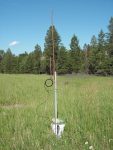© Calla Kessler/The Washington Post
Balloons and caution tape line the perimeter of the Capital Gazette building in Annapolis after the June 2018 shooting that killed five employees.
Federal officials have approved a site on the National Mall for the capital’s first memorial dedicated to journalists who have died while reporting the news and to the role of the free press in a democracy, the foundation planning the project announced Monday.
The Fallen Journalists Memorial will be located on a third-of-an-acre parcel in Southwest Washington between the National Museum of the American Indian and the Voice of America building. The location is bordered by Independence and Maryland avenues and Third Street SW.
The site, which has a direct view of the Capitol, was chosen to evoke journalists’ role as government watchdogs. The memorial is projected to open in 2028 and will cost as much as $50 million, which will be entirely funded by private donations. Officials said they have commitments to cover 40 percent of the cost so far.
The Fallen Journalists Memorial Foundation is working with architecture critic Paul Goldberger to identify architects, designers and artists to create a “commemorative landscape that represents the full breadth of journalism — past, present, and future,” according to a news release. The memorial will honor slain journalists, convey the dangers they face and provide a spot for reflection.
Barbara Cochran, the president of the foundation, said planners envision an outdoor memorial that melds with the surrounding green space, but they do not have other specific features in mind. She said plans do not include a roofed museum or other indoor space.
Cochran said the memorial will not include names of slain journalists because of rules governing using names on memorials in D.C. and the logistics of having to update the memorial in perpetuity. The foundation will maintain a list of fallen journalists online, but Cochran said the criteria for inclusion are still being ironed out.
The foundation will also curate programming and digital materials to educate the public about the history of the First Amendment and the role of reporters in a democracy.
“It is amazing there hasn’t been such a memorial up to now,” Cochran said. “With the increasing threats and dangers to journalists, it seems it’s needed now more than ever.”
The Committee to Protect Journalists reported that at least 67 reporters and media workers were killed worldwide in 2022 — a 50 percent increase over 2021 and the highest number since 2018. The increase was driven by journalist deaths during the war in Ukraine and a large uptick in the killing of reporters in Latin America, according to CPJ.
David Dreier, who started the Fallen Journalists Memorial Foundation, said he was inspired to seek the memorial after a gunman shot and killed five employees at the Capital Gazette in Annapolis in 2018. The attack remains the deadliest assault against journalists in the nation’s history. The Gazette was then owned by Tribune Publishing.
Four years later, Annapolis remembers Capital Gazette shooting victims
Dreier, a former congressman and former chairman of Tribune Publishing, said he realized at that same time that the Newseum — a D.C. museum dedicated to journalism — was shutting down and that there was nothing commemorating slain journalists on the Mall, even as they were coming under increasing attack at home and abroad.
Dreier said he consulted with a number of other major figures in the news business, including former Washington Post publisher Don Graham, before forging ahead on an effort to construct a memorial. Congress approved the Fallen Journalists Memorial Act in 2020, allowing the project to move forward. President Donald Trump signed the bill into law the same year.
The U.S. Commission of Fine Arts signed off on the site location on Thursday. The next step will be selecting a design proposal for the memorial, which officials hope will happen early next year.
“This will be the first memorial on the National Mall that is actually about an idea,” Dreier said. “That idea is the First Amendment and journalists who died in the pursuit of the truth.”
Phil Davis, a former criminal justice reporter at the Capital Gazette, said he was appreciative of the effort to create a new memorial. He said that one way to help prevent tragedies like the one that befell the Gazette was by not forgetting what happened and that a memorial was an important way to do that.
“I wish it wasn’t necessary, but it so is in this country,” Davis said.


